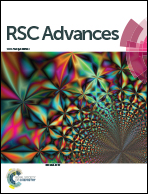Effect of ZnO, SiO2 dual shells on CeO2 hybrid core–shell nanostructures and their structural, optical and magnetic properties
Abstract
This work has investigated the structural, optical and magnetic properties of ceria-based core–shell nanostructures synthesized by a simple and effective precipitation method. Formation of the core CeO2 and shells of ZnO as well as SiO2 over the core is confirmed by the X-ray diffraction (XRD) pattern, Fourier transform infra-red spectroscopy (FTIR), field emission scanning electron microscopy (FESEM) and high resolution transmission electron microscopy (HRTEM). The optical properties of the core–shell nanostructures are determined by UV-visible spectroscopy and photoluminescence (PL) studies. From XRD results it can be seen that the core CeO2 exhibits cubic fluorite and hexagonal ZnO shell structures. A core–shell nanostructure with complete coating of SiO2 on CeO2@ZnO is evidenced by FTIR. UV-visible spectra show broad absorption maxima in the UV region and also show a shift in the band edge for core–shell nanostructures which demonstrate the electronic structural modification in the core–shell nanoparticles. Magnetic studies show room temperature ferromagnetic order in the low field region with significant coercivity, which may be associated with defect-related ferromagnetic exchange in the core–shell nanostructures.


 Please wait while we load your content...
Please wait while we load your content...